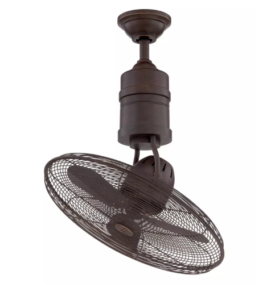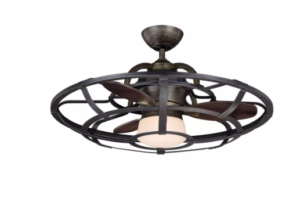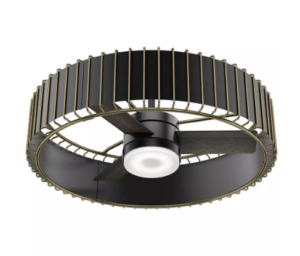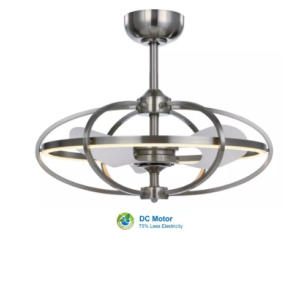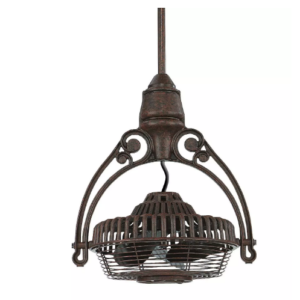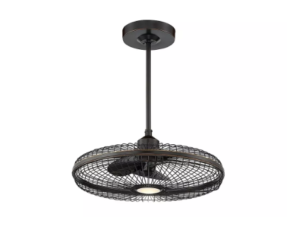We looked at dozens of fans to bring you the very best enclosed ceiling fans on the market today. Wondering what an enclosed ceiling fan is? Read our buyer’s guide at the bottom of the page! In it, we cover tons of information for you to make the most informed decision on purchasing a ceiling fan. We hope you like it!
The Craftmade Bellows III fan is UL rated for both indoors and outdoor damp locations. The fan features a 82mm x 25 mm powerful 3- speed reversible AC Motor that makes it very lightweight and long lasting. The 7 degree blade pitch distributes air in the room evenly.
The Bellows III comes with a 4” downrod and equipped with 170- degree tilt feature to provide breeze in every area nearby. It also features a 360 degree oscillation for all round movement. The model includes a 3 speed intelligent wall control as well as a remote control. You get the best cooling experience under its variable speed of 854 RPM to 1335 RPM.
Craftmade makes fans to suit the needs of every space you can imagine. This range of fans is made to produce strong breeze for every direction in its vicinity. With the Craftmade Bellows III, you don’t have to tilt the fan or adjust your resting position to get maximum breeze anymore.
The Savoy House Alsace Fan comes with a White Etched Glass and a single light fixture to amplify your existing room decor. The fixture consists of one 75W Halogen Mini which can sufficiently illuminate a large room. The 120mm x 20 mm AC motor makes it highly functional but is not as energy efficient as a DC motor. DC motors tend to run a bit quieter as well.
The 13.5 degree blade pitch makes it a perfect solution for smaller living spaces like. Along with other controls, this fan comes with a hand held remote control with an independent light control. Although the wind speed factor is strong at 4.28 MPH, the airflow and efficiency rating is below average. With this fan, we think the larger appeal is the enclosed nature and beautiful aesthetic that it provides.
The Savoy House fans are stylish, decorative and energy efficient. This model is made from reclaimed wood so it’s very environment-friendly. The design is a remnant of the chandelier style that will become the focal point of any room.
The Hunter Vault in matte black and modern brass is a minimal enclosed ceiling fan for your contemporary décor. It features a 153 x 15 mm WhisperWind AC motor that attributes to its quiet and smooth function. However, it needs more balancing at high speeds. The 30” blade span makes it ideal for small sitting areas or lounges.
The airflow is 2595 CFM (half of the average) and the wind speed factor of 3.74 MPH (just above the average). Thus it gives you a strong cooling breeze when you are sitting near to it, but it won’t cool a large room down beyond a few feet directly beneath it. The fan has an average efficiency rating of 68 CFM/Watt but the performance is long lasting. It comes with a 3 speed remote control. The model also comes with its own Vault Light kit accessory.
The Hunter Vault Ceiling fans are made to impress its onlookers. The fans are not just high- contrast artistry but also highly effective at cooling. The minimal craftsmanship is a must if you want to add contemporary vibes to your interiors.
The Maxim Corona Fandelier comes with a LED ring surrounding the fan blades. The device features smooth curved bands that seamlessly intertwine with each other for a stunning and intricate design. The super efficient DC Motor promises a better energy efficiency than typical AC motor fans. Moreover, it runs smooth with minimum noise levels.
The 46 Watt Dimmable LED lights are perfect to set the right ambiance in any room. The wind speed factor is 11.71 MPH – enough wind-chill to cool you off in a few minutes. You can expect instant cooling and a very strong breeze in the room. However, with an average airflow of 5057 CFM, you get a limited breeze to a smaller diameter of the room.
The Maxim fans hold the attention of your guests with their stunning design and superlative performance. This enclosed fandelier in Satin Nickel has complex designs to lift the aesthetics of any simple interior décor. Moreover, it is reasonably priced and doesn’t disappoint with its performance as well.
The Fanimation Old Havana is a ceiling Mount Fan designed to meet your fresh air requirement indoor and outdoor-dry or damp locations. The fan features a 0.75 Amp AC Motor that gives it durability and long hours of undeterred performance. The 19” blade span and a 25 degree blade pitch throw wind to with a wide angle.
The model comes with a 3-speed non-reversing rotary control attached to its back – no other control options are available. With a quality rating of five out of five, it wins hearts for a quiet and smooth performance without making any wobbling noise. This is certainly one of the best enclosed fans on the market.
Fanimation fans are a go-to choice to collect memories of heritage ceiling fans. The Old Havana Ceiling Mount fan is a part of the Fanimation’s Ernest Hemmingway collection. It is not only functional but also stylish that constantly reminds you of the bygone era.
The Savoy House Wetherby Fan Dlier features a small caged fan and a mighty LED light kit together. The overall design throws a vintage vibe with a classic bronze finish. The DC motor runs smooth but with a low efficiency rating of 39 CFM/Watt. However, on the plus side, the motor consumes only 37 watts per hour which is fantastic in terms of energy savings.
With respect to its purpose of serving small indoor rooms, the 1471 CFM airflow is below average. That makes it not useful for outdoor locations. But, you can use it in bathrooms and other smaller rooms as the fan is UL rated for damp locations in covered areas only. To offer an ease of use, it comes with a handheld remote control with 3 speeds, reverse and dimmer functions.
Savoy House is a trusted name in the fan and lighting industry. The designs have always provoked buyers which come with an uncompromised performance quality. With this Wetherby Fan Dlier In Classic Bronze, Savoy scores another perfect five in quality rating to take the industry by surprise.
As an affiliate partner, we may earn from qualifying purchases made on these products.
An enclosed Ceiling Fan Buyer’s Guide: Everything To Know When Buying an enclosed Fan.
We have a deep love for ceiling fans and live to help others understand these products as well as we do. That is why we took the time to write a ceiling fan buyers’ guide.
Buying an enclosed ceiling fan for the first time can be overwhelming. There are many options for fans and each fan has different styles, sizes, functionality, blades, and installation steps. The enclosement themselves come in different patterns and designs.
Fortunately for you, we have distilled all of the key variables down into an accessible and digestible guide. You can read this guide if you want an in-depth understanding of ceiling fans or you can skim it if you only want to better understand certain aspects of the fan itself.
This includes how to select a fan to buy, the types and angles of a fan’s blades, the pros and cons of the AC and DC motors that power fans, and how to install the fan on your ceiling. If you follow this guide you can be confident that you are making a well informed buying decision.
We know all things ceiling fans and want to pass on our learnings and insights to help you.
Most importantly, we know that once you evaluate, select, and install a ceiling fan it will likely remain in place for many years to come. That is because enclosed ceiling fans can be heavy, expensive, and labor intensive to install.
What is an enclosed fan? Why would someone want one?
An enclosed fan is, as the name implies, a fan protected by an exterior coating, metal casing, or fabric.
The enclosement can cover either the entire fan or a portion of it.
Sometimes lower enclosements are popular for protecting lighting, especially for those owners who have kids playing with indoor sports equipment near the fan itself. T
In general, the enclosement is for aesthetics and lightweight protection and can serve as a useful safety mechanism.
If you have kids playing sports (flying footballs or baseballs) an enclosement can protect the glass lighting on the fan as well.
Most enclosements are made of solid metal, metal composite, or fabric.
What is the importance of an enclosed ceiling fan?
Enclosed ceiling fans provide you an energy efficient way to heat or cool your home or outdoor space.
A central air conditioning system consumes 3 kiloWatts, which is about 36 cents per hour. Running a fan only runs at 30 Watts, equivalent to only a cent per hour.
This makes fans affordable and energy efficient alternatives that many people love as they are good for you, your wallet, and the environment.
Running an enclosed fan that turns off when a certain temperature range is reached is even more affordable.
Take the time to do research now before buying because the switching costs of changing your mind can be high.
Go through this evaluation check-list so that you better understand the types of motors, blades, installation units, and fans that exist. We encourage you to optimize for:
- Overall quality: in particular the speed of the motor to optimize for cooling efficacy and quietness.
- Aesthetics: in particular ensure that you are happy with how the fan looks, its color, shape, design, and blade count.
- Size: select the right size fan for the room you will be placing it in. Larger rooms require larger fans to create strong air flow.
Selecting the location of the enclosed ceiling fan: Inside or Outside
Most enclosed ceiling fans are used within the home. Others are for outdoor structures. Before deciding which type of fan to buy, determine where you will place it. Understanding the placement of a ceiling fan will help you select other attributes – like size, speed, and sound – that will enhance your experience with the fan.
Outdoor enclosed ceiling fans require different electrical strategies and water-proof finishes. The enclosement needs to be rust-proof as well if it will come into contact with sunlight or water (rain, snow).
Please keep this mind throughout the guide as we largely focus our attention and advice to those people who want to install indoor fans.
If placing the enclosed ceiling fan in an indoor room, measure the size of the room.
Bathrooms tend to be smaller than bedrooms which tend to be smaller than living rooms or kitchens.
Knowing the approximate size of the room in which the fan will be placed is important.
Larger fans are best suited to larger rooms as their blades and motors move greater volumes of air.
Ceiling Fan Size Chart
| Room (in feet) | Cubic Feet/Minute | Fan Size |
| 6′ x 6′ | 3,000 – 4,500 | Shop: 24″ to 36″ |
| 10′ x 10′ | 4,000 – 5,500 | Shop: 37″ to 48″ |
| 12′ x 12′ | 6,200 – 7,500 | Shop: 49″ to 56″ |
| 15′ x 15′ | 7,000 – 9,000 | Shop: 60″ to 72″ |
| Larger | 9,000 – 11,000 | Shop: 80″ to 99″ |
The length of the blade of the fan and the size of the room go hand in hand.
In short, if you have a large room, buy a larger fan. The bigger the fan the better.
The common sizes for ceiling fans are 36, 44 and 52 inches, with the large fans having a blade wingspan of 60 inches.
Of course you can technically go even larger, with the largest recreational home fans having up to 99 inches of wingspan.
99 inches is 8.25 feet. That is a large fan indeed.
Measure the height of the ceiling and allow at least 7 feet and 6 inches of space.
It is wise and safe to place your fan at least 7 feet above your flooring.
Placing a enclosed ceiling fan high up protects tall individuals from hitting their head or having their hair caught while the fan is in motion. Fans need to be installed on ceilings and these installation bases take space as well.
An installation base is adjoined to a downrod, which is a simple piece of metal that the fan is connected to and hangs from.
The average American ceiling height today is 9 feet (2.7432 meters). This means that the average room can support a fan but with a shorter downrod.
If you have average sized ceilings you can afford to install no more than 1 foot and 6 inch downrods.
How to measure downrods and base mounts
An enclosed ceiling fan is composed of fan blades, a downrod, an installation base, and an enclosement that either fits around the entirety of the fan or around portions of the fan (usually the lighting fixtures).
The installation base attaches to the ceiling. The downrod connects to the base. And the fan itself hangs from the downrod.
Per the measurements mentioned above, the fan must be at least 7 feet and 6 inches above the ground if you have a standard 9 foot ceiling.
There is one exception: fans placed above beds, where you will not walk, require less height.
Many people enjoy selecting the fit and finish of the downrod as these pieces of metal or plastic come in different colors, shapes, and sizes and compliment the overall fan’s aesthetic.
As a general rule, more expensive ceiling fans enable you to have longer and more customizable downrods. The downdrods tend to be longer – between 6 and 18 inches.
This is for functionality and aesthetics. Cheaper ceiling fans sometimes have very short – or almost nonexistent downrods – because the base and the fan are fused together.
Design and Look: What to Think about an enclosed fan’s general aesthetics
A hugely important aspect of a ceiling fan is what it looks like. If you see the fan while lying in bed or while in your living room you will want it to look great.
The base and downrod are not nearly as important as the blades for how a fan looks in a room.
Blades come in different cuts, lengths, seizes, finishes, colors and of course quantities.
How many blades should an enclosed fan have? Do more blades make a fan better?
At a minimum, an enclosed ceiling fan will have two blades though four or five are certainly more common.
A two blade fan can be made of one long piece of metal connected at the mid-point or two distinct blades.
Blades add functionality and impact the air flow.
When you look at an enclosed fan that is turned on, the blades are hard to see. The enclosement itself is always visible. In fact, more often than not, the enclosement fully covers the blades of the fan so you won’t see them.
When the fan is stationary, however, the design and color of the blades will need to align with your preferences for style and decor.
Fans with four to six blades produce a lower pitch, softer volume noise output. Three blade fans use the air surrounding the fan most efficiently and require the least effort to clean as you have fewer blades and surface area to collect dust.
The color, material, and quantity of the blades impact how the fan looks and performs.
Another subtle variable is at play too: the angles of those blades. If the blades are too flat, they won’t whisk through the air and create air flows. We highly advise blades with angles between 12 and 14 degrees.
Nearly all of the fans we provide you here have angles in that range for optimal air circulation and air flow efficacy.
More than a fan: how an enclosed fan provides lighting, symmetry, and aesthetic benefits.
Some people buy ceiling fans simply to cool or heat a room. Others buy ceiling fans because they can be elegant and add character to a home. Some fans have lights and others do not.
If you are going to place your enclosed fan in the center of a room – for example, your living room – you might do so at the expense of a central lighting system.
For this reason, adding lights to fans is popular. If you add lights you will want to also consider how easy it is to change the bulbs, especially if the fan is very high above your floor.
Enclosements can cover the entire fan or just a portion, such as each individual light.
LED, Halogen, and Fluorescent lighting options are available on all fans that have integrated lighting.
Control Your Environment: Noise and Air Flow
Fans without lights produce two types of energy outputs when they are on: noise and air-flow. Both will impact your experience with the fan. Fans with lights also produce illumination as an energy output.
Firstly, noise is a byproduct of any fan. The rotation of the blades and the motor can cause distinct sounds. Larger motors produce more power and, as a result, can generate more noise.
The good news is that noise can be mitigated.
Motors that are built from higher quality and durable screws, armature, bearings, windings, and rotors are more expensive.
Cheaper enclosed fans have motors that usually produce more noise as a byproduct.
If you want a quieter fan, buy a more expensive one. You won’t regret it.
Please pay particular attention to this when considering which type of fan you will place in different rooms in your home. If you are considering a bedroom ceiling fan, it is prudent to optimize for minimal sound.
People tend to care less about noise when a fan is in a garage or bathroom.
The second type of energy output is air-flow.
Fans can not only cool rooms, they can also heat rooms and reduce air moisture.
They substitute central cooling or work in conjunction with air conditioning.
Fans do not lower air temperatures. They produce air flows and circulation which can in turn create the effect of a windchill.
The wind chill temperature is how cold people feel. The air flow, which leads to evaporative cooling (deratification), is generated by the ceiling fan.
If you are using a fan for general room cooling, you will want a fan that accelerates the heat loss from exposed skin.
Put simply, you will want a fan that generates significant air-flows point downwards and towards the center of the room.
Air Flow Deep Dive: Cubic Feet per Minute
Air flow is the volume of air that is produced by the fan.
The most common way to measure air flow is Cubic Feet per Minute (or CFM).
All of the fans we review have a CFM rating so that you can easily compare how much air that each fan produces.
The average CFM is around 5,000.
For nearly all non-industrial use-cases, like your home bedroom, kitchen, living room, or garage, a CFM of 6,000-7,000 is optimal.
At this rate you will be left feeling cooler without greatly enhancing your energy bill or having papers strewn all over the place from the powerful wind currents that larger fans produce.
You might also see a measurement similar to CFM which is air (or wind) Miles Per Hour.
Much like measuring the speed at which one drives, a fan can have its air speed measured too.
Nearly all fans produce between 3 and 5 Mile Per Hour air flows. Naturally, the higher the MPH, the stronger the air flows.
Controlling Your Fan and Your Energy Output for Efficiency
Mobile apps and the internet have changed how we communicate, manage, and control various technologies.
Enclosed ceiling fans are no exception.
Ceiling fans are well suited for management by a digital switch, remote, or mobile app because you can power the fans on or off (or even alter the speed) from afar.
A connected fan is controlled via a remote control or smartphone. In contrast, less expensive and simpler fans are controlled via a manual switch.
Lastly, some enclosed ceiling fans are controlled by pull chains.
While chains are usually made long enough for all users to reach them, please keep in mind that this can cause discomfort or annoyance on high ceilings or fans that need to be frequently turned on or off.
If you plan on installing your fan over 9 feet above the ground, you should buy a fan that can be controlled digitally.
All ceiling fans can create air-flows bi-direactionally.
Usually a simple switch exists on the fan’s motor or external base that enables you to change the direction in which the blades rotate.
Changing the directional air propulsion is critical during the winter months.
Rather than have air convected from the center of the room for cooling, you will want air to move from the blades horizontally down through the walls.
Lateral air-flow is used for heating rooms and maintaining central warmth while reducing your energy bill.
Choosing the right ceiling fan direction
How you control your enclosed ceiling fan is correlated with how much energy your fan uses. Will you leave it running all the time? Or will you use smart logic to power it down after a certain amount of time?
We have gone above and beyond to think about fans not just as cooling mechanisms but as a tool that can help you save money while lowering your ecological footprint. These efforts will, most importantly, save you money.
Let me explain further.
When you use central cooling or air conditioners, you are physically reducing the temperature in a room.
An air conditioner sucks air into its ducts through a vent. This air cools the gas in the evaporator and as the heat is removed from the air, it is cooled. Cool air then flows into your room.
This process is energy intensive and expensive.
In contrast, a ceiling fan does not cool the room or remove heat. Rather, it moves air around which creates the feeling of cooling. Actual cooling is not occurring. Less energy out means less energy in. And in total this means a lower energy bill.
What An Enclosed Ceiling Lan Looks Like To You and Others
This guide provides ample information pertaining to how a ceiling fan works and things you should be aware of before buying one or many fans for your home.
What we have not discussed in great depth is how an enclosed ceiling fan looks and the importance of design aesthetics.
A fan will need to fit aesthetically into your room and, as a result, you should think about material (wood, metal, plastic), color, and design patterns. Some questions to reflect on:
- Is the room light or dark? Is it naturally well lit or does it require lots of electrical light?
If your ceiling fan is going in the center of your living room, for example, you will likely want a fan with built-in lighting. This is because many living rooms have existing fixture hardware and wiring.
- Do you want a smart fan that connects with your digital applications and services (Google Home, Nest Apple Siri, Amazon Alexa)?
If you control other aspects of your home – like the temperature and humidity – via smart apps, you might want to add a ceiling fan as another connected Internet of Things device. Likewise if you have high ceilings and plan to install a fan that you can’t easily reach by hand.
Smart fans can be controlled via your phone, tablet, or voice, and these controls will make turning them on or off easier.
- What color do you want the enclosed fan to be? What style finish do you want for the enclosement?
Sleek and minimalist fans have fewer blades. These fans, made of lightweight metal, have universal white, grey, or black finishes. Most enclosements are darker or tan colors.
Where to buy an enclosed ceiling fan?
Enclosed ceiling fans are heavy and can be difficult to fit in a car or to transport yourself unless you have a large vehicle or flat-bed truck. Given this, it makes a lot of sense to have your fan shipped to you so that it arrives ready for home assembly.
You can self-install a ceiling fan. This work requires moderate technical skills and physical strength. This is because you will need to install not only the fan (the blades) but you will need to connect the fan’s base to the ceiling and its electrical fixture hardware and wiring.
How much does an enclosed ceiling fan cost? What impacts the price of a fan?
enclosed ceiling fans range in price from $75 on the cheap-end to over $1,300 on the high-end. There are several reasons why the range in price is so large.
An enclosed ceiling fan, made of plastic instead of more durable wood or metal, is cheaper.
Additionally, less expensive enclosed fans have weaker motors. This means that they are capable of producing less air flow or have smaller Cubic Feet per Minute scores.
More expensive fans are akin to those you would experience at a resort or high end hotel. A ceiling fan over $1,200 will likely come packed with high tech solutions built-in.
These fans will enable you to:
- Program the fan based on motion, temperature, or humidity.
- Turn the fan on or off based on preset logic or rules for maximum physical comfort.
- Enjoy very efficient and quiet DC motors that have multi-decade support and lifetime expectations.
Moreover, these enclosed pricer fans come with app based (smart phone, iPad) mobile management and remote controls.
It is common for expensive ceiling fans to come with mount options so that you can install a panel adjacent to your light switch. These wall mounts enable you to control not only the fan (on/off) but also the fan speed and direction.
Cheaper enclosed fans do not come with these in depth level of controls or sophisticated management features.
And that is ok. Simplicity might be what you crave.
Cheaper enclosed fans cool rooms as well and can be easily turned on/off with pull chains.
Less expensive fans (in the $100-$300 price point) still come with energy-efficient dimmable lightbulbs.
AC vs DC fans: Understanding a fan’s power source
Most inexpensive enclosed fans leverage AC motors.
Although AC motors are more powerful than DC motors, they typically are less efficient and are not as good at using their energy output.
This can cause additional noise (thereby making it harder to sleep if that fan is in your bedroom).
When buying an enclosed fan, please take a moment to see the Power Source listed in the fan’s essential product information that all suppliers provide. If you buy a fan with an AC motor, it will be louder.
As a result, we highly advise buying a DC powered fan if you will be sleeping near it.
AC motors are durable and longer lasting. While this might seem positive, DC motors are better (and therefore more costly).
DC motors are simpler to install into the fan’s base, have high startup power, and have a faster response time.
This means that time will be shortened from when you switch the “on” button to when the fan is accelerating to cool your room.
Although more expensive, ceiling fans with DC motors consume 70% less power which will enable you to save money over time as you pay less to power them.
Where to place the enclosed ceiling fan: voltage and flush mounting
Many people place their ceiling fans in the center of a room or above a bed. This is to maximize comfort and the impact of the fan’s air flows.
A centrally placed ceiling fan also creates room symmetry.
Voltage is the pressure from an electrical circuit’s power, and the most common electrical outlet in any home is a 110 volt. If you live in the United States, you will need to select a fan that complies with this voltage limit.
Luckily for you, nearly all off-the-shelf ceiling fans support this standard.
When installing an enclosed ceiling fan you will need to get a few things absolutely right. We have done this many times for ourselves, our family, friends, and of course our clients.
Firstly, some ceiling fans support flush mount integrations. Flush mount fans sit directly against the ceiling and point downwards. These fans are typically useful for cooling a small room.
Not all ceiling fans are flush mountable.
This means that they will hang lower from the ceiling. If you buy a fan that cannot be flush mounted, please ensure that the lower point of the fan is at least 7 feet and six inches from the ground.
Additionally, ensure that the weight bearing load of the ceiling can support the fan.
Similar to voltage, this should be routine in many homes.
But it is worth investigating because you don’t want to buy a fan just to see it unable to stay upright.
For most fans that we review and see our clients deploy, a ceiling must be able to support approximately 35 pounds of downward pressure.
Buyer’s Guide Summary: Bringing It All Together
Buying an enclosed ceiling fan for the first time does not need to be overwhelming.
Simply follow this guide to evaluate and buy the fan that fits best in your room and adds the most value in your life.
Don’t get too bogged down in the details. If nothing else, pick an enclosed ceiling fan that looks great, fits well within your room, and that is priced according to your budget.
If the fan is going into your bedroom, it is worth spending a bit more for a quitter product – you won’t regret it.
If you have kids, indoor flying objects (read: pets), or outside animals (read: birds), an enclosement that is strong is great for ease of mind, simplicity, protection, and reducing the risk of stuff getting into the fan or breaking lights.


